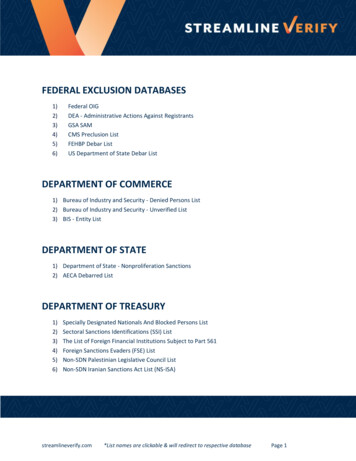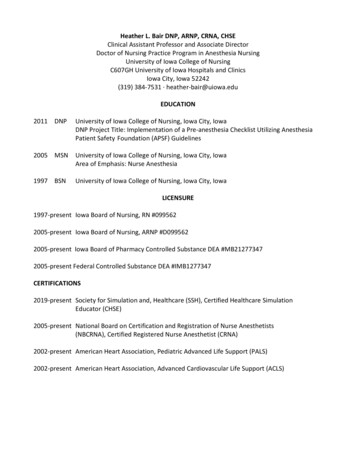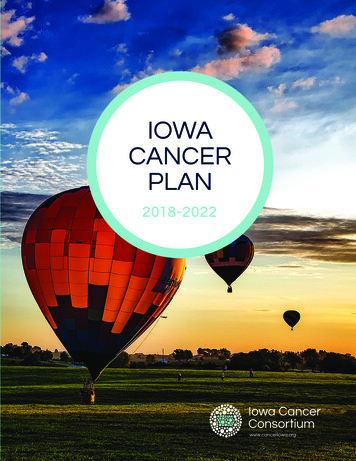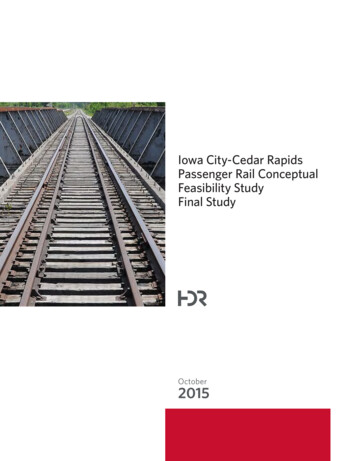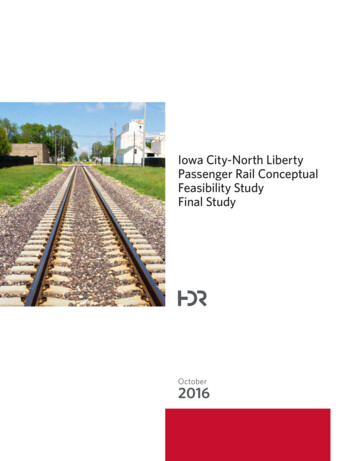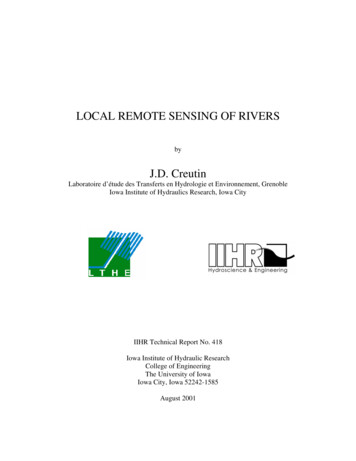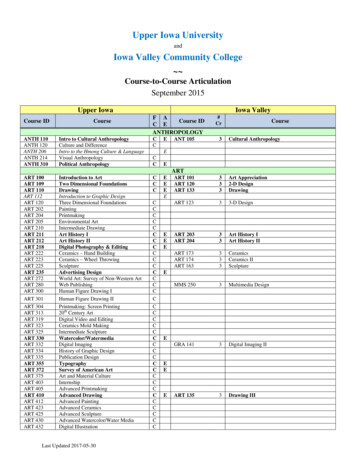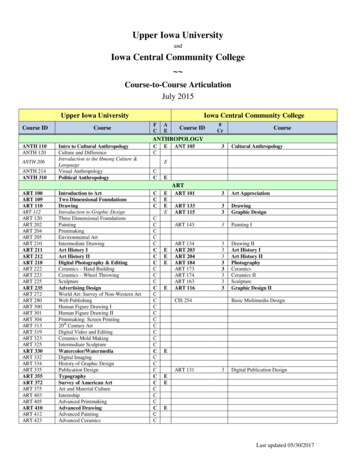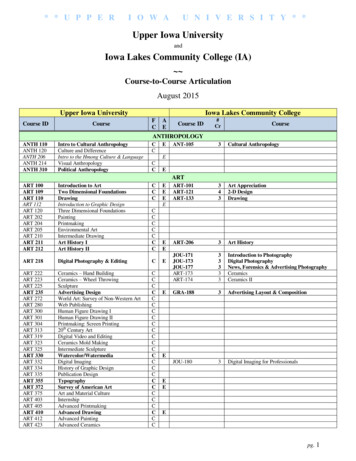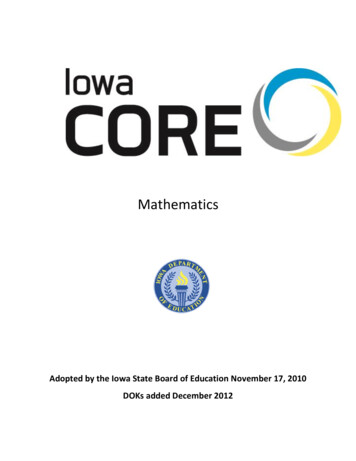
Transcription
MathematicsAdopted by the Iowa State Board of Education November 17, 2010DOKs added December 2012
Table of ContentsIntroduction . 3Mathematics Standards for Mathematical Practice . 8Mathematics Kindergarten . 11Mathematics Grade 1. 15Mathematics Grade 2. 19Mathematics Grade 3. 23Mathematics Grade 4. 29Mathematics Grade 5. 35Mathematics Grade 6. 41Mathematics Grade 7. 47Mathematics Grade 8. 53Mathematics Standards for High School . 58Mathematics High School—Number and Quantity . 59Mathematics High School—Algebra . 63Mathematics High School—Functions . 68Mathematics High School—Modeling . 73Mathematics High School—Geometry . 75Mathematics High School— Statistics and Probability . 82Glossary . 88Sample of Works Consulted. 95The Role and Importance of Cognitive Complexity . 98Disclaimer: The language provided may not be modified in any way.Page 2 of 100
IntroductionIowa Core Mathematics includes recommendations for curriculum, instruction, and assessment, as well asstandards for mathematical content and mathematical practices. In particular, Iowa Core Mathematics is builtupon: Iowa Core’s Characteristics of Effective Instructiono Teaching for Understandingo Student-Centered Classroomso Teaching for Student Differenceso Rigor and Relevanceo Assessment for LearningCommon Core State Standards for Mathematicso Standards for Mathematical Practiceo Standards for Mathematical ContentTo faithfully implement Iowa Core Mathematics requires teaching with rich mathematical tasks.Rich Mathematical TasksAs stated in Common Core Mathematics, “Mathematical understanding and procedural skill are equally important,and both are assessable using mathematical tasks of sufficient richness.” (p. 6). By teaching through richmathematical tasks, students develop deep conceptual understanding and skill proficiency. Rich mathematicaltasks involve both: Teaching through Problem Solving with Problem-Based Instructional TasksUsing Distributed Practice that is Meaningful and PurposefulProblem-Based Instructional TasksProblem-based instructional tasks are at the heart of teaching for understanding. A world-class mathematicscurriculum should be built around rich instructional tasks focused on important mathematics.Problem-based instructional tasks: Help students develop a deep understanding of important mathematics Emphasize connections, across mathematical content areas, to other disciplines, and especially to the realworld Are accessible yet challenging to all Can be solved in several ways Encourage student engagement and communication Encourage the use of connected multiple representations Encourage appropriate use of intellectual, physical, and technological toolsDistributed Practice that is Meaningful and PurposefulPractice is essential to learn mathematics. However, to be effective in improving student achievement, practicemust be meaningful, purposeful, and distributed.Meaningful Purposeful Distributed Practice: Meaningful: Builds on and extends understanding Purposeful: Links to curriculum goals and targets an identified need based on multiple data sources Distributed: Consists of short periods of systematic practice distributed over a long period of timeDisclaimer: The language provided may not be modified in any way.Page 3 of 100
Toward greater focus and coherenceMathematics experiences in early childhood settings should concentrate on (1) number(which includes whole number, operations, and relations) and (2) geometry, spatialrelations, and measurement, with more mathematics learning time devoted to numberthan to other topics. Mathematical process goals should be integrated in these contentareas.- Mathematics Learning in Early Childhood, National Research Council, 2009The composite standards [of Hong Kong, Korea and Singapore] have a number offeatures that can inform an international benchmarking process for the development ofK–6 mathematics standards in the U.S. First, the composite standards concentrate theearly learning of mathematics on the number, measurement, and geometry strands withless emphasis on data analysis and little exposure to algebra. The Hong Kong standardsfor grades 1–3 devote approximately half the targeted time to numbers and almost allthe time remaining to geometry and measurement.- Ginsburg, Leinwand and Decker, 2009Because the mathematics concepts in [U.S.] textbooks are often weak, the presentationbecomes more mechanical than is ideal. We looked at both traditional and nontraditional textbooks used in the US and found this conceptual weakness in both.- Ginsburg, et al., 2005There are many ways to organize curricula. The challenge, now rarely met, is to avoidthose that distort mathematics and turn off students.- Steen., 2007For over a decade, research studies of mathematics education in high-performing countries have pointed to theconclusion that the mathematics curriculum in the United States must become substantially more focused andcoherent in order to improve mathematics achievement in this country. To deliver on the promise of commonstandards, the standards must address the problem of a curriculum that is "a mile wide and an inch deep." TheseStandards are a substantial answer to that challenge.It is important to recognize that “fewer standards” are no substitute for focused standards. Achieving "fewerstandards" would be easy to do by resorting to broad, general statements. Instead, these Standards aim for clarityand specificity.Assessing the coherence of a set of standards is more difficult than assessing their focus. William Schmidt andRichard Houang (2002) have said that content standards and curricula are coherent if they are:articulated over time as a sequence of topics and performances that are logical andreflect, where appropriate, the sequential or hierarchical nature of the disciplinarycontent from which the subject matter derives. That is, what and how students aretaught should reflect not only the topics that fall within a certain academic discipline,but also the key ideas that determine how knowledge is organized and generated withinthat discipline. This implies that to be coherent, a set of content standards must evolvefrom particulars (e.g., the meaning and operations of whole numbers, including simplemath facts and routine computational procedures associated with whole numbers andfractions) to deeper structures inherent in the discipline. These deeper structures thenserve as a means for connecting the particulars (such as an understanding of the rationalnumber system and its properties). (emphasis added)Disclaimer: The language provided may not be modified in any way.Page 4 of 100
These Standards endeavor to follow such a design, not only by stressing conceptual understanding of key ideas,but also by continually returning to organizing principles such as place value or the properties of operations tostructure those ideas.In addition, the "sequence of topics and performances" that is outlined in a body of mathematics standards mustalso respect what is known about how students learn. As Confrey (2007) points out, developing "sequencedobstacles and challenges for student.absent the insights about meaning that derive from careful study oflearning, would be unfortunate and unwise." In recognition of this, the development of these Standards beganwith research-based learning progressions detailing what is known today about how students’ mathematicalknowledge, skill, and understanding develop over time.Disclaimer: The language provided may not be modified in any way.Page 5 of 100
Understanding mathematicsThese Standards define what students should understand and be able to do in their study of mathematics. Asking astudent to understand something means asking a teacher to assess whether the student has understood it. Butwhat does mathematical understanding look like? One hallmark of mathematical understanding is the ability tojustify, in a way appropriate to the student’s mathematical maturity, why a particular mathematical statement istrue or where a mathematical rule comes from. There is a world of difference between a student who can summona mnemonic device to expand a product such as (a b)(x y) and a student who can explain where the mnemoniccomes from. The student who can explain the rule understands the mathematics, and may have a better chance tosucceed at a less familiar task such as expanding (a b c)(x y). Mathematical understanding and procedural skillare equally important, and both are assessable using mathematical tasks of sufficient richness.The Standards set grade-specific standards but do not define the intervention methods or materials necessary tosupport students who are well below or well above grade-level expectations. It is also beyond the scope of theStandards to define the full range of supports appropriate for English language learners and for students withspecial needs. At the same time, all students must have the opportunity to learn and meet the same highstandards if they are to access the knowledge and skills necessary in their post-school lives. The Standards shouldbe read as allowing for the widest possible range of students to participate fully from the outset, along withappropriate accommodations to ensure maximum participation of students with special education needs. Forexample, for students with disabilities reading should allow for use of Braille, screen reader technology, or otherassistive devices, while writing should include the use of a scribe, computer, or speech-to-text technology. In asimilar vein, speaking and listening should be interpreted broadly to include sign language. No set of grade-specificstandards can fully reflect the great variety in abilities, needs, learning rates, and achievement levels of students inany given classroom. However, the Standards do provide clear signposts along the way to the goal of college andcareer readiness for all students.The Standards begin on page 8 with eight Standards for Mathematical Practice.Disclaimer: The language provided may not be modified in any way.Page 6 of 100
How to read the grade level standardsStandards define what students should understand and be able to do.Clusters are groups of related standards. Note that standards from different clusters may sometimes be closelyrelated, because mathematics is a connected subject.Domains are larger groups of related standards. Standards from different domains may sometimes be closelyrelated.Taxonomy Codes are unique, alpha-numeric identifiers for each standard.Depth-of-Knowledge Codes are cognitive complexity codes based on Webb’s Depth-of-Knowledge that areassigned to each standard.DomainNumber and Operations in Base Ten3.NBTUse place value understanding and properties of operations to perform multi-digit arithmetic.1. Use place value understanding to round whole numbers to the nearest 10 or 100.(3.NBT.1.) (DOK 1)2. Fluently add and subtract within 1000 using strategies and algorithms based on place value,Standardproperties of operations, and/or the relationship between addition and subtraction.(3.NBT.2.) (DOK 1,2)3. Multiply one-digit whole numbers by multiples of 10 in the range 10-90 (e.g., 9 80, 5 60)using strategies based on place value and properties of operations. (3.NBT.3.) (DOK 1,2)Taxonomy CodeClusterDepth-of-Knowledge CodeThese Standards do not dictate curriculum or teaching methods. For example, just because topic A appears beforetopic B in the standards for a given grade, it does not necessarily mean that topic A must be taught before topic B.A teacher might prefer to teach topic B before topic A, or might choose to highlight connections by teaching topicA and topic B at the same time. Or, a teacher might prefer to teach a topic of his or her own choosing that leads, asa byproduct, to students reaching the standards for topics A and B.What students can learn at any particular grade level depends upon what they have learned before. Ideally then,each standard in this document might have been phrased in the form, "Students who already know . should nextcome to learn ." But at present this approach is unrealistic—not least because existing education research cannotspecify all such learning pathways. Of necessity therefore, grade placements for specific topics have been made onthe basis of state and international comparisons and the collective experience and collective professionaljudgment of educators, researchers and mathematicians. One promise of common state standards is that overtime they will allow research on learning progressions to inform and improve the design of standards to a muchgreater extent than is possible today. Learning opportunities will continue to vary across schools and schoolsystems, and educators should make every effort to meet the needs of individual students based on their currentunderstanding.These Standards are not intended to be new names for old ways of doing business. They are a call to take the nextstep. It is time for states to work together to build on lessons learned from two decades of standards basedreforms. It is time to recognize that standards are not just promises to our children, but promises we intend tokeep.Disclaimer: The language provided may not be modified in any way.Page 7 of 100
Mathematics Standards for Mathematical PracticeThe Standards for Mathematical Practice describe varieties of expertise that mathematics educators at all levelsshould seek to develop in their students. These practices rest on important "processes and proficiencies" withlongstanding importance in mathematics education. The first of these are the NCTM process standards of problemsolving, reasoning and proof, communication, representation, and connections. The second are the strands ofmathematical proficiency specified in the National Research Council’s report Adding It Up: adaptive reasoning,strategic competence, conceptual understanding (comprehension of mathematical concepts, operations andrelations), procedural fluency (skill in carrying out procedures flexibly, accurately, efficiently and appropriately),and productive disposition (habitual inclination to see mathematics as sensible, useful, and worthwhile, coupledwith a belief in diligence and one’s own efficacy).1.Make sense of problems and persevere in solving them.Mathematically proficient students start by explaining to themselves the meaning of a problem andlooking for entry points to its solution. They analyze givens, constraints, relationships, and goals. Theymake conjectures about the form and meaning of the solution and plan a solution pathway rather thansimply jumping into a solution attempt. They consider analogous problems, and try special cases andsimpler forms of the original problem in order to gain insight into its solution. They monitor and evaluatetheir progress and change course if necessary. Older students might, depending on the context of theproblem, transform algebraic expressions or change the viewing window on their graphing calculator toget the information they need. Mathematically proficient students can explain correspondences betweenequations, verbal descriptions, tables, and graphs or draw diagrams of important features andrelationships, graph data, and search for regularity or trends. Younger students might rely on usingconcrete objects or pictures to help conceptualize and solve a problem. Mathematically proficientstudents check their answers to problems using a different method, and they continually ask themselves,"Does this make sense?" They can understand the approaches of others to solving complex problems andidentify correspondences between different approaches.2.Reason abstractly and quantitatively.Mathematically proficient students make sense of quantities and their relationships in problem situations.They bring two complementary abilities to bear on problems involving quantitative relationships: theability to decontextualize—to abstract a given situation and represent it symbolically and manipulate therepresenting symbols as if they have a life of their own, without necessarily attending to their referents—and the ability to contextualize, to pause as needed during the manipulation process in order to probeinto the referents for the symbols involved. Quantitative reasoning entails habits of creating a coherentrepresentation of the problem at hand; considering the units involved; attending to the meaning ofquantities, not just how to compute them; and knowing and flexibly using different properties ofoperations and objects.3.Construct viable arguments and critique the reasoning of others.Mathematically proficient students understand and use stated assumptions, definitions, and previouslyestablished results in constructing arguments. They make conjectures and build a logical progression ofstatements to explore the truth of their conjectures. They are able to analyze situations by breaking theminto cases, and can recognize and use counterexamples. They justify their conclusions, communicate themto others, and respond to the arguments of others. They reason inductively about data, making plausiblearguments that take into account the context from which the data arose. Mathematically proficientstudents are also able to compare the effectiveness of two plausible arguments, distinguish correct logicor reasoning from that which is flawed, and—if there is a flaw in an argument—explain what it is.Elementary students can construct arguments using concrete referents such as objects, drawings,diagrams, and actions. Such arguments can make sense and be correct, even though they are notgeneralized or made formal until later grades. Later, students learn to determine domains to which anargument applies. Students at all grades can listen or read the arguments of others, decide whether theymake sense, and ask useful questions to clarify or improve the arguments.Disclaimer: The language provided may not be modified in any way.Page 8 of 100
4.Model with mathematics.Mathematically proficient students can apply the mathematics they know to solve problems arising ineveryday life, society, and the workplace. In early grades, this might be as simple as writing an additionequation to describe a situation. In middle grades, a student might apply proportional reasoning to plan aschool event or analyze a problem in the community. By high school, a student might use geometry tosolve a design problem or use a function to describe how one quantity of interest depends on another.Mathematically proficient students who can apply what they know are comfortable making assumptionsand approximations to simplify a complicated situation, realizing that these may need revision later. Theyare able to identify important quantities in a practical situation and map their relationships using suchtools as diagrams, two-way tables, graphs, flowcharts and formulas. They can analyze those relationshipsmathematically to draw conclusions. They routinely interpret their mathematical results in the context ofthe situation and reflect on whether the results make sense, possibly improving the model if it has notserved its purpose.5.Use appropriate tools strategically.Mathematically proficient students consider the available tools when solving a mathematical problem.These tools might include pencil and paper, concrete models, a ruler, a protractor, a calculator, aspreadsheet, a computer algebra system, a statistical package, or dynamic geometry software. Proficientstudents are sufficiently familiar with tools appropriate for their grade or course to make sound decisionsabout when each of these tools might be helpful, recognizing both the insight to be gained and theirlimitations. For example, mathematically proficient high school students analyze graphs of functions andsolutions generated using a graphing calculator. They detect possible errors by strategically usingestimation and other mathematical knowledge. When making mathematical models, they know thattechnology can enable them to visualize the results of varying assumptions, explore consequences, andcompare predictions with data. Mathematically proficient students at various grade levels are able toidentify relevant external mathematical resources, such as digital content located on a website, and usethem to pose or solve problems. They are able to use technological tools to explore and deepen theirunderstanding of concepts.6.Attend to precision.Mathematically proficient students try to communicate precisely to others. They try to use cleardefinitions in discussion with others and in their own reasoning. They state the meaning of the symbolsthey choose, including using the equal sign consistently and appropriately. They are careful aboutspecifying units of measure, and labeling axes to clarify the correspondence with quantities in a problem.They calculate accurately and efficiently, express numerical answers with a degree of precisionappropriate for the problem context. In the elementary grades, students give carefully formulatedexplanations to each other. By the time they reach high school they have learned to examine claims andmake explicit use of definitions.7.Look for and make use of structure.Mathematically proficient students look closely to discern a pattern or structure. Young students, forexample, might notice that three and seven more is the same amount as seven and three more, or theymay sort a collection of shapes according to how many sides the shapes have. Later, students will see 7 8 equals the well remembered 7 5 7 3, in preparation for learning about the distributive property. Inthe expression x2 9x 14, older students can see the 14 as 2 7 and the 9 as 2 7. They recognize thesignificance of an existing line in a geometric figure and can use the strategy of drawing an auxiliary linefor solving problems. They also can step back for an overview and shift perspective. They can seecomplicated things, such as some algebraic expressions, as single objects or as being composed of severalobjects. For example, they can see 5 – 3(x – y)2 as 5 minus a positive number times a square and use thatto realize that its value cannot be more than 5 for any real numbers x and y.Students who look for patterns in their environment expect things to make sense and develop a habit offinding relationships and making predictions. Students should investigate patterns in number, shape,data, change, and chance. They should be given opportunities to learn how to represent those patternsnumerically, geometrically and/or algebraically.Disclaimer: The language provided may not be modified in any way.Page 9 of 100
8.Look for and express regularity in repeated reasoning.Mathematically proficient students notice if calculations are repeated, and look both for general methodsand for shortcuts. Upper elementary students might notice when dividing 25 by 11 that they are repeatingthe same calculations over and over again, and conclude they have a repeating decimal. By payingattention to the calculation of slope as they repeatedly check whether points are on the line through (1,2) with slope 3, middle school students might abstract the equation (y – 2)/(x – 1) 3. Noticing theregularity in the way terms cancel when expanding (x – 1)(x 1), (x – 1)(x2 x 1), and (x – 1)(x3 x2 x 1) might lead them to the general formula for the sum of a geometric series. As they work to solve aproblem, mathematically proficient students maintain oversight of the process, while attending to thedetails. They continually evaluate the reasonableness of their intermediate results.Connecting the Standards for Mathematical Practice to the Standards for Mathematical ContentThe Standards for Mathematical Practice describe ways in which developing student practitioners of the disciplineof mathematics increasingly ought to engage with the subject matter as they grow in mathematical maturity andexpertise throughout the elementary, middle and high school years. Designers of curricula, assessments, andprofessional development should all attend to the need to connect the mathematical practices to mathematicalcontent in mathematics instruction.The Standards for Mathematical Content are a balanced combination of procedure and understanding.Expectations that begin with the word "understand" are often especially good opportunities to connect thepractices to the content. Students who lack understanding of a topic may rely on procedures too heavily. Withouta flexible base from which to work, they may be less likely to consider analogous problems, represent problemscoherently, justify conclusions, apply the mathematics to practical situations, use technology mindfully to workwith the mathematics, explain the mathematics accurately to other students, step back for an overview, or deviatefrom a known procedure to find a shortcut. In short, a lack of understanding effectively prevents a student fromengaging in the mathematical practices.In this respect, those content standards which set an expectation of understanding are potential "points ofintersection" between the Standards for Mathematical Content and the Standards for Mathematical Practice.These points of intersection are intended to be weighted toward central and generative concepts in the schoolmathematics curriculum that most merit the time, resources, innovative energies, and focus necessary toqualitatively improve the curriculum, instruction, assessment, professional development, and student achievementin mathematics.Disclaimer: The language provided may not be modified in any way.Page 10 of 100
Mathematics KindergartenIn Kindergarten, instructional time should focus on two critical areas: (1) representing, relating,and operating on whole numbers, initially with sets of objects; (2) describing shapes and space.More learning time in Kindergarten should be devoted to number than to other topics.(1) Students use numbers, including written numerals, to represent quantities and to solve quantitativeproblems, such as counting objects in a set; counting out a given number of objects; comparing sets ornumerals; and modeling simple joining and separating situations with sets of objects, or eventually withequations such as 5 2 7 and 7 – 2 5. (Kindergarten students should see addition and subtractionequations, and student writing of equations in kindergarten is encouraged, but it is not required.)Students choose, combine, and apply effective strategies for answering quantitative questions, includingquickly recognizing the cardinalities of small sets of objects, counting and producing sets of given sizes,counting the number of objects in combined sets, or counting the number of objects that remain in a setafter some are taken away.(2) Students describe their physical world using geometric ideas (e.g., shape, orientation, spatial relations)and vocabulary. They identify, name, and describe basic two-dimensional shapes, such as squares,triangles, circles, rectangles, and hexagons, presented in a variety of ways (e.g., with different sizes andorientations), as well as three-dimensional shapes such as cubes, cones, cylinders, and spheres. They usebasic shapes and spatial reasoning to model objects in their environment and to construct more complexshapes.Disclaimer: The language provided may not be modified in any way.Page 11 of 100
Grade K OverviewCounting and Cardinality Know number names and the count sequence.Count to tell the number of objects.Compare numbers.Mathematical Practices1.Make sense of problems andpersevere in solving them.2.Reason abstractly and quantitatively.3.Construct viable arguments andcritique the reasoning of others.4.Model with mathematics.5.Use appropriate tools strategically.6.Attend to precision.7.Look for and make use of structure.8.Look
Standards define what students should understand and be able to do. Clusters are groups of related standards. Note that standards from different clusters may sometimes be closely related, because mathematics is a connected subject. Domains are larger groups of related standards. Standards from different domains may sometimes be closely related.
